Dive Destinations
Liveaboards
Resorts / Day Trips
Scuba Training
...Highlights: shark action, manta rays, turtles, great macro life/marine diversity, schooling fish & big pelagics...
...Diving environment: healthy reefs, wall dives, drifts, beginner and advanced divers, off the beaten track...
Fiji is a tourist destination with so much to offer: hiking, nature, fabulous beaches and wonderful local people, that sometimes the quality of the diving can be overlooked. Anyone who has been diving in Fiji however, will tell quite a different story. From luxury resorts and remote eco-hideaways to fabulous liveaboards, Fiji scuba diving really does offer something for everyone. Conditions and underwater sights vary greatly here and while some places are tranquil and great for learning, others will enjoy some current, ranging from barely perceptible to very strong. It is the presence off current that makes the diving in Fiji so rich.
Currents are the lifeblood of Fiji's reefs, kick-starting the food chain by sweeping in nutrients to both corals and fish alike. Fiji is known by divers as "The Soft Coral Capital of the World" and when the current flows the corals bloom into fabulous displays of colourful splendour. The currents also affect the water's visibility which can be the best around, with the incoming currents bringing clear water into the lagoons and then flushing out any cloudy lagoon water.
Lagoons are a feature of the Fijian Islands and often the water remains shallow until some distance from shore. This means that most of the diving is conducted from boats and also that the shorelines are great for adults and children alike to go snorkelling and swimming.
So where do you want to go? Read more on all these top Fiji dive spots:
Whether you are based in a single location, go for a combination booking or Fiji liveaboard, you would be well advised to ensure any trip here includes these excellent areas:
The Garden Island, past which runs the Somosomo Strait whose soft coral splendour allows Fiji to lay claim to being 'The soft coral capital of the world'. The waters around Taveuni and south into the Koro Sea are rich and nutrient-filled, supporting large marine ecosystems which means lots of great dive sites. Taveuni, a large island in the north east of the country and is one of the most popular destinations for diving in Fiji; a short flight is needed from Viti Levu. The Somosomo Strait dive sites are blessed with amazing soft coral coverage; vibrant bushes of orange and brown and pink proliferate and blossom fully when current is present.
Famous dive sites include Rainbow Reef, a site so colourful that its seems like all the hues are represented. Adding to the soft coral tableau are swarms of orange basslets, Christmas tree worms, crinoids and nudibranchs creating a feast for the eyes. There is also a considerable amount of pristine hard acropora coral here too surrounded by smaller fish like moorish idols, long nose butterflyfish, and redtooth triggerfish. Larger creatures in the blue can include whitetip reef sharks, barracuda and leopard sharks.
The Great White Wall is another renowned site with some unique features. At one stage of the dive, after finning over a flat coral garden, you will swim through a little tunnel and emerge at a stunning sheer wall. In optimal conditions this drop-off is positively covered in an explosion of blueish-white soft corals... an arresting sight! Interestingly, as you go deeper the white becomes lavender. Marine life here includes squarespot anthias, squirrelfish, fairy basslets, and soldierfish. However it is the sessile spectacle that gives this site its unique place among the hierarchy for diving in Fiji.
In addition to the big names dive sites, Taveuni has plenty more to offer. Annies' Bommies is a fascinating hard coral site, Fish Factory as you might expect promises a lot of fish species and numbers and Paradise Reef is one of those house reefs where you can spend hours in the shallows and never get bored!
This region is possibly the richest of all in the Fiji's underwater realm. While this larger area is definitely the preserve of liveaboards, you can get a glimpse of Bligh Water's splendour if diving from the Rakiraki area of Viti Levu. There is a large amount of water moving through these large channels meaning nutrient rich water supports a huge amount of marine life; from sharks to shrimps, barracuda to blennies.
Among the headline dive sites here are Namena Island and Nigali Passage where you can expect to drift among eagle rays, manta rays, grey reef sharks, silvertips and maybe even hammerheads. in more sheltered spots you can dive around the soft corals and marvel at the myriad crustaceans, pipefish and nudibranchs that inhabit every nook and cranny. When you experience colourful, life-filled and fun dive sites like these you will understand why diving in Fiji is so highly rated among those in the know.
The real Fiji, away from the big resorts where life can go at the pace you want and where the diving feels like the last frontier. Eco-friendly resorts, local culture and plenty of breathtaking sites in and around the well-known Great Astrolabe Reef.
This area boats some of the best hard coral coverage that diving in Fiji has to offer. There is a mixture of easy diving here on fringing reefs with moderate currents, to more exposed pinnacles where currents sweep and pelagics play.
Relaxed diving is on offer at sites like Yellow Wall where you can potter around a fish-filled reef surrounded by sergeant majors, exquisite wrasses and triggerfish. Broken Stone offers an interesting maze-like topography of caverns, swimthroughs and passages inhabited by lobsters, butterflyfish and yellow-breasted wrasses.
Naiqoro Passage is typical of the more adrenalin-filled sites of Kadavu. This narrow channel sees nutrient-rich water gushing through bringing soft corals of purple, orange and red. Schools of sweetlips, snapper are present here in numbers, facing the current, mouths agape. Meaty potato cod also make great photographic opportunities if you can manage your camera in the current.
One of Fiji's best kept secrets is the top quality scuba diving at Rakiraki with colourful pristine reefs and an abundance of fish. Special mention too must go the shark feeding dives conducted in the waters off Pacific Harbour. You can have heart-stopping moments with the bosses of the ocean and just off Fiji's main island. Read about our very own experience here: The Best Shark Dive in the World.
Probably the best overall diving location for people staying in Viti Levu can be found in Rakiraki. Sites here are suitable for divers of all abilities and include pinnacles, shallow coral gardens and sheer walls. Impressive numbers and variety of colourful reef fish swarm these sites and larger species to be seen include turtles, mantas, grey reef sharks, whitetips and blacktips. Spanish dancers and myriad nudibranchs also pepper the reefs.
One of the undoubted diving highlights for many in Fiji, is the incredible experience to be had at Shark Reef at Pacific Harbour. This is an amazing opportunity to see some of the Pacific's meatiest and meanest looking sharks up close as they are fed by experts. Kneel in a semi-circle and stare agog at the passing sharks; up to 8 different species! Many add a day of 2 shark feeding dives to their scuba trip to Fiji no matter where else they dive. It is a great way to end your vacation!
Just south of Viti Levu lies Beqa Island, one of the most popular diving destinations in Fiji for those seeking to avoid a domestic flight. There are a range of good dive spots around the lagoon and the islands that fringe it. You can expect pinnacles, plenty of soft corals and even wrecks.
Beqa Lagoon has a long-established reputation as one of the best areas for diving in the Pacific. Although these days such praise is not really merited, there remain plenty of very good sites keeping Beqa listed among the best diving in Fiji. Sites of note include Seven Sisters, a series of 7 small submerged pinnacles, home to a variety of soft corals, fans and crinoids in shades of purple, yellow, orange and pink. Creatures of note here include octopus, moray eels, flatworms and nudibranchs plus swarms of anthias and basslets flitting over the corals.
E.T. is a rather unusually named dive site in Beqa Lagoon and it has a rather unusual profile. Essentially it consists of a tunnel that splits into 2 chambers fully bedecked in sessile life: cup corals. soft corals, gorgonians and encrusting sponges. Small creatures like shrimps and crabs lurk in every fissure while nudibranchs, sea slugs, lionfish and moray eels also appear everywhere. There may even be the occasional nurse shark resting on the sandy floor.
For more information on your diving options, and all the other travel information you might need to visit, view our Fijian liveaboard or dive resort and day trips sections.
Geographically there are so many islands that you have to decide whether you wish to travel to experience the best scuba diving Fiji has to offer or you want to stay put in one place and get a taste of that area alone. If doing the former then there can surely be no substitute for a Fiji liveaboard cruise which will cover more sites than any land-based experience and which will also give you the chance to dive the more remote and less-visited spots.
If you want to stay in 1 place only and dive exclusively in 1 area then your best choice again depends on what exactly you are looking for. Stay on Taveuni to see the soft coral splendour of the Somosomo Strait, and Kadavu Island is the place to go to get away from it all and explore the Great Astrolabe Reef. We include full details of all the resorts in these destinations, suitable for all budgets, in our Fiji dive resorts sections: Kadavu, Taveuni, Viti Levu (Pacific Harbour and Nadi).
Since most international flights arrive in Viti Levu no-one should plan a diving vacation here without including the experience of the shark-feeding dives in Viti Levu as a great complement to your liveaboard trip or resort package elsewhere in the Fijian islands.
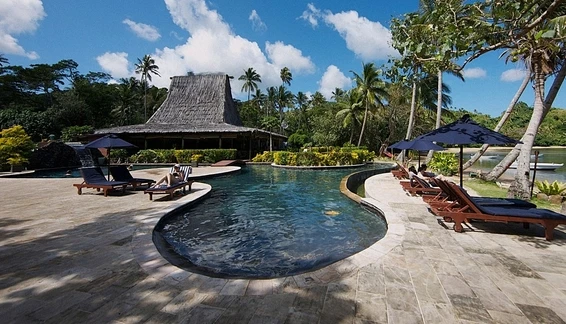 Beqa Lagoon Resort
Beqa Lagoon Resort
Customer rating: Excellent!
 Pacific Harbour Daytrips
Pacific Harbour Daytrips
Customer rating: Excellent!
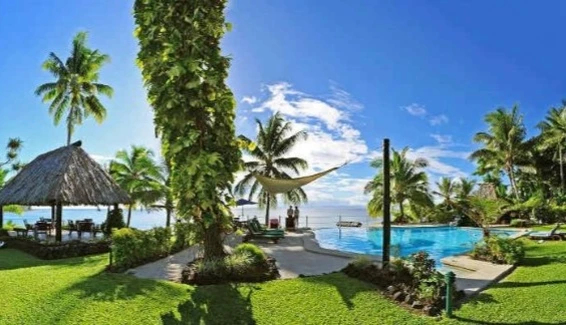 Paradise Taveuni Resort
Paradise Taveuni Resort
Customer rating: Excellent!
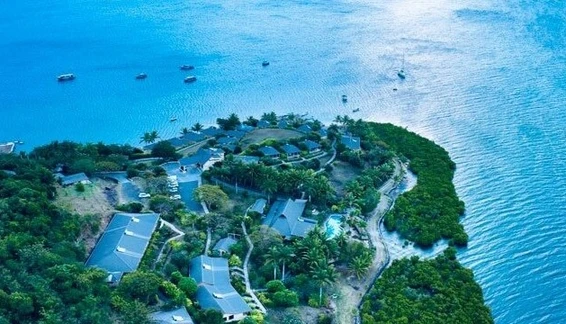 VoliVoli Resort
VoliVoli Resort
Customer rating: Excellent!
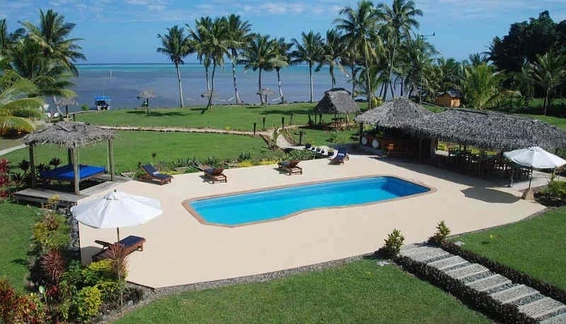 Waidroka Bay Resort
Waidroka Bay Resort
Customer rating: Excellent!
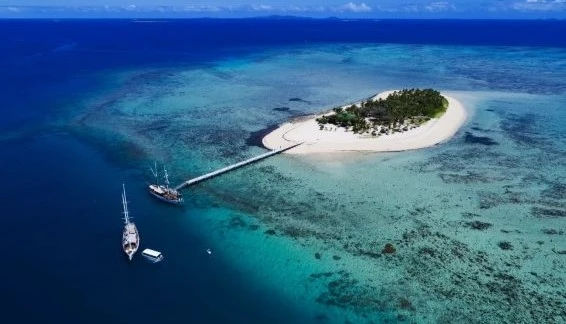 Nadi / Mamanuca Islands Daytrips
Nadi / Mamanuca Islands Daytrips
Customer rating: Be first to rate!
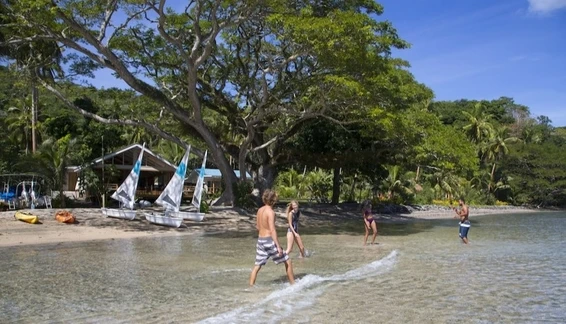 Sau Bay Resort & Spa
Sau Bay Resort & Spa
Customer rating: Be first to rate!
The dive season is all year round. The winter months of April to October represent the main season for scuba diving in Fiji in terms of visitor numbers, although the visibility tends to peak between the months of July and December when the water is cooler (sometimes, although seldom as cool as 22°C). 25°C is a realistic expectation of water temperatures during this period. It can cool enough in this period to reduce plankton activity sufficiently for the visibility to rise to impressive distances, sometimes exceeding 50m.
November to April are in fact Fiji's summertime and when the seas are at their warmest - around 28 to 30°C. This is also rainy season and December to March carries a greater risk of cyclones. Run-off from the rivers can reduce the otherwise excellent visibility, particularly on dive sites off the coast of Viti Levu.
For comfort and protection, many choose to dive with a 5 mm full length wetsuit during winter months from May to October, and a 3 mm full length or shortie during summer months from November to April.
The transition months, where the seasons cross-over are often considered ideal times to visit. They are November, April and May. Things also vary from place to place within Fiji. Morning showers in the highlands of Viti Levu are quite common at any time of the year. Bligh Water's excellent visibility is seldom reduced significantly even during wet season. Plankton blooms, particularly in rainy season can attract larger creatures such as plankton-feeding whales and manta rays.
For more information on the climate in Fiji, visit the Climates To Travel website.
Review our map below of the Fiji Islands and their location in the world. Here, you will find information on how to get to Fiji.
5 - >40m
15 - 40m
None to very strong
Mostly calm but can be choppy further from shore particularly during July to September
normally 28 - 30°C
Beginner - advanced
>150
2 - 3 weeks
No Hassles - everything was executed without any problems, very easy and your people are very friendly
